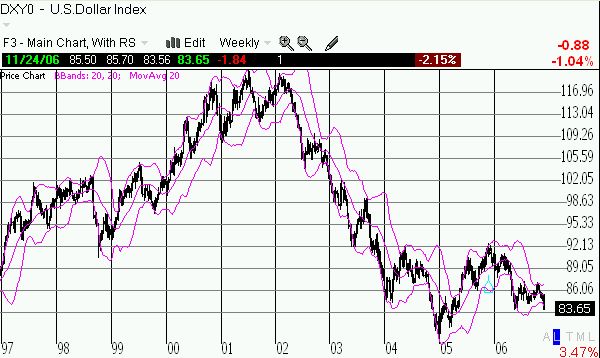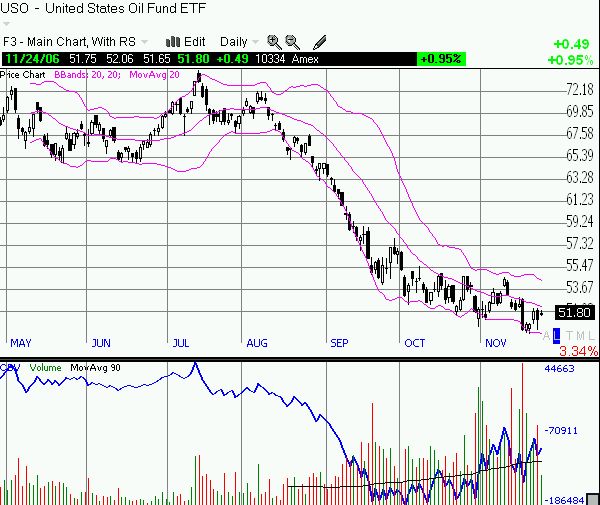As shoppers mobbed the stores on "Black Friday", the currency they use for their holiday excess dropped in value. Again. A relatively steep 2-day decline of 2%. In fact, the chart below reminds us that the current bull run in the stock market is happening at same time the currency continues to be trapped in a 4 1/2 year bear market.

Over the recent years there have been many false recoveries for the dollar. But all compasses point down. As the Fed steadily increased interest rates in 2005, the dollar went on its longest recovery run since 2000. But 2006 has brought back more of the same. Given that the Fed seems to be all but done trying to fight inflation, the U.S. remains intent on building more and more debt, and the bond markets are playing along with the economic slowdown scenario, the dollar is not likely to regain momentum anytime soon. This means that the after adjusting for currency values, the U.S. stock market will continue to lag many markets around the world, including the older industrialized nations (for just a few examples, check out the 2-3 year moves in EZA, EWZ, EWJ, EWA, EWC, and EWP). In parallel, gold (according to the gold ETF) is up 25% on the year. Gold was up as much as 40% as when the commodity inflation "scare" peaked back in May. With the dollar getting weaker, gold getting stronger, we have to wonder whether the inflation picture is as benign as we are being led to believe.
In fact, Federal Reserve Governor Kevin Warsh remarked on Tuesday that he believes the market is too optimistic about the inflation outlook:
"Inflation, though down somewhat from its level earlier this year, remains uncomfortably elevated. Financial market prices imply that inflation will continue its gradual but persistent downward track during the forecast period. There remain, I believe, clear upside risks to that inflation outlook.
Prices on federal funds futures and Eurodollar futures suggest that market participants expect the FOMC to cut the target federal funds rate about 50 basis points during 2007, a view consistent with expectations of a "soft landing." At the same time, market-based options prices on these interest rate futures indicate that implied volatilities are quite low, suggesting a surprising degree of certainty regarding policy expectations. Taken at face value, market participants appear to be reasonably certain of a benign outcome for both economic growth and inflation. In contrast, my own judgmental forecast includes a wider range of possible outcomes than is implicit in these market-based measures."
Now, we already know that the Fed has limited options on interest rates. I still maintain the Fed will raise one more time to appear serious about fighting inflation, but overall, the latest inflation talk sounds like more of the typical jawboning. Another reason to think that the Fed may yet hike rates one more time is that the stock market is telling us it can withstand one more blow. In the aforementioned speech, Warsh talks about how the Fed looks to the market for information: "...policymakers benefit greatly by listening to views expressed in markets that are at least somewhat independent of FOMC communications...You [the market] watch us and react to our actions, while simultaneously we monitor you and respond as best we can to the signals you provide about evolving economic and financial conditions." I suspect the Fed is hearing from the stock market that corporate profit growth will be fine, robust even. Thus, it should be "safe", in fact, necessary, to raise rates again - residual risks to the housing market notwithstanding.
The merger and acquisition (M&A) action in the steel and copper sectors also seem to support future inflationary prospects. Just last week, Freeport-McMoRan Copper & Gold (FCX) put in a bid to take out copper producer Phelps Dodge (PD). And within another day or so, rumors were already running around that BHP Billiton Ltd. (BHP) would turn around and make a bid for FCX. Also last week, Moscow-based Evraz Group signed a deal to take out steel tube maker Oregon Steel (OS). (I think that means my oft-liked Lone Star Technologies is the last publicly-traded, independent U.S. steel company focused on making steel tubing?!) I first got interested in OS right at the high for commodities in 2005. OS did not retake this high until the beginning of this year. Anyway, the deal for OS occured days after rumors rippled through the financial markets about interest in taking out U.S. Steel (X). I began writing about X back in July, 2005 as an example of what looked like a potential bubble in steel at the time. Many mergers later, it looks like the steel industry is ready for a serious rebound that will weather well any coming slowdown. The increasing concentration of supply power across and throughout the entire commodities sector/industry means higher prices for buyers. Companies are not being bought at or near the lows in stock prices. Instead, acquisitions are happening at premiums above and beyond prices that are often at or approaching 52-week/all-time highs! Under these conditions, we should assume that pricing power, rather than cost-savings, motivate many of these deals. Why is this important? Supports for pricing power also support inflation. Cost-cutting supports a reduction in prices. I see additional inflation risks.
Finally, let's take a look at oil. It seems that the recent benign inflation data has benefited from the recent collapse in oil prices. But how much further down can oil go? OPEC is slowly but surely getting serious about defending some price level for oil, perhaps from $50 to 55. I still say that only a recession will prevent oil prices from recovering soon. The new ETF for the oil commodity, USO, demonstrates some interesting behavior. If I did not know any better, I would say that the surge in volume on this ETF represents accumulation, rather than pessimistic abandonment of the oil story.

Note also that even that on-balance volume (OBV) is bouncing back on USO - further suggesting that the buyers have more conviction than the sellers. Time will soon confirm or debunk my suspicions on oil, but my bet remains with the bullish story for oil (click here for disclaimer). And if oil goes back up, inflation should follow.
And before you think I have suddenly become bearish, I will point out that I stick by my "all clear" for the bulls missive on October 22. I will also point you to this article by Jon Markman stating that the on-going boom in leveraged buy-outs, insider buying, share repurchases, and mergers and acquisitions signal to us that the "smart money" is positioning itself for many more gains to come in the stock market: "Why You're Down When the Market's Up."
Be careful out there!